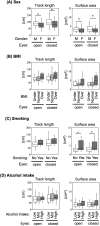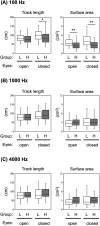Improvement of balance in young adults by a sound component at 100 Hz in music
- PMID: 30442994
- PMCID: PMC6237978
- DOI: 10.1038/s41598-018-35244-3
Improvement of balance in young adults by a sound component at 100 Hz in music
Abstract
About 80% of young people use personal listening devices (PLDs) including MP3 players to listen to music, which consists of sound components with various frequencies. Previous studies showed that exposure to noise of high intensities affected balance in humans. However, there is no information about a frequency-dependent effect of sound components in music from a PLD on balance in young people. In this study, we determined the associations between sound component levels (dB) at 100, 1000 and 4000 Hz in music from a portable listening device (PLD) and balance objectively determined by posturography in young adults (n = 110). We divided the subjects into two groups (low and high exposure groups) based on cut-off values of sound component levels at each frequency using receiver operating characteristic (ROC) curves. Balance in the high exposure group (≥46.6 dB) at 100 Hz was significantly better than that in low exposure group in logistic regression models adjusted for sex, BMI, smoking status and alcohol intake, while there were no significant associations at 1000 and 4000 Hz. Thus, this study demonstrated for the first time that the sound component at 100 Hz with more than 46.6 dB in music improved balance in young adults.
Conflict of interest statement
The authors declare no competing interests.
Figures


Similar articles
-
Early Indication of Noise-Induced Hearing Loss in Young Adult Users of Personal Listening Devices.Ann Otol Rhinol Laryngol. 2018 Oct;127(10):703-709. doi: 10.1177/0003489418790284. Epub 2018 Jul 28. Ann Otol Rhinol Laryngol. 2018. PMID: 30056742
-
Headphone listening habits, hearing thresholds and listening levels in Swedish adolescents with severe to profound HL and adolescents with normal hearing.Int J Audiol. 2018 Oct;57(10):730-736. doi: 10.1080/14992027.2018.1461938. Epub 2018 Apr 27. Int J Audiol. 2018. PMID: 29703094
-
Low body mass index and jaw movement are protective of hearing in users of personal listening devices.Laryngoscope. 2013 Aug;123(8):1983-7. doi: 10.1002/lary.23955. Epub 2013 Apr 1. Laryngoscope. 2013. PMID: 23553325 Clinical Trial.
-
Analysis of Factors Affecting Output Levels and Frequencies of MP3 Players.Korean J Audiol. 2013 Sep;17(2):59-64. doi: 10.7874/kja.2013.17.2.59. Epub 2013 Sep 24. Korean J Audiol. 2013. PMID: 24653908 Free PMC article. Review.
-
Music Tuned to 440 Hz Versus 432 Hz and the Health Effects: A Double-blind Cross-over Pilot Study.Explore (NY). 2019 Jul-Aug;15(4):283-290. doi: 10.1016/j.explore.2019.04.001. Epub 2019 Apr 6. Explore (NY). 2019. PMID: 31031095 Review.
Cited by
-
Postural regulation and stability with acoustic input in normal-hearing subjects.HNO. 2020 Aug;68(Suppl 2):100-105. doi: 10.1007/s00106-020-00846-9. HNO. 2020. PMID: 32377779 Free PMC article.
-
Just 1-min exposure to a pure tone at 100 Hz with daily exposable sound pressure levels may improve motion sickness.Environ Health Prev Med. 2025;30:22. doi: 10.1265/ehpm.24-00247. Environ Health Prev Med. 2025. PMID: 40128952 Free PMC article.
-
The Role of Background Acoustic Stimuli in Dual Tasks: A Study on Postural Control Performance.Brain Behav. 2025 Aug;15(8):e70750. doi: 10.1002/brb3.70750. Brain Behav. 2025. PMID: 40791077 Free PMC article. Clinical Trial.
-
Effects of Auditory Frequency Stimulation on Balance and Rehabilitation Outcomes in Patients With Stroke: A Randomized Case-Control Study.Brain Behav. 2025 Jul;15(7):e70671. doi: 10.1002/brb3.70671. Brain Behav. 2025. PMID: 40621706 Free PMC article. Clinical Trial.
-
[Postural regulation and stability with acoustic input in normal hearing subjects. German version].HNO. 2020 May;68(5):344-351. doi: 10.1007/s00106-020-00845-w. HNO. 2020. PMID: 32219489 German.
References
-
- Ansari H, Mohammadpoorasl A. Using Earphone and its Complications: An Increasing Pattern in Adolescents and Young Adults. Health Scope. 2016;5:e321301.
Publication types
MeSH terms
LinkOut - more resources
Full Text Sources
Miscellaneous

